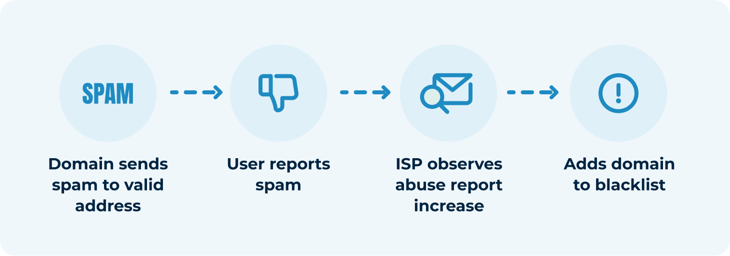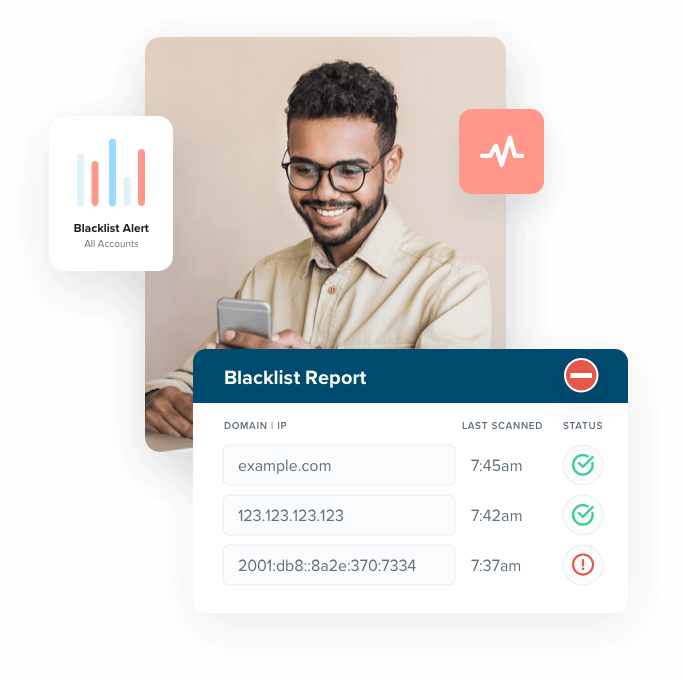Free IP & Domain Blacklist Checker
Monitor your domain reputation with a blacklist checker
If you find yourself on an IP blacklist or email blacklist, your email deliverabilityⓘA sender’s ability to reach the recipient’s inbox with their outgoing emails. It may also describe the ratio of emails delivered to the inbox vs. those sent to spam or blocked by the receiving server. will suffer. Take advantage of ZeroBounce’s free blacklist checker to stay on top of email spam prevention and find out if your domain is at risk.
How does an email blacklist work?
Email blacklist services track your domain reputation. Spamming your email list with too many messages or emailing invalid addresses will result in spam complaints and email bounces.
Additionally, emailing users that did not opt-in to receive your content can prompt spam complaints, which may place you on an email blacklist.
Email blacklist is an abbreviation of real-time blackhole list (RBL) or DNS blacklist (DNSBL). Blacklists are present at the domain level, an email blacklist, and at the internet service provider (ISP) level, an IP blacklist. Both assist in spam prevention to protect everyday email users.
If you find yourself on an email blacklist or IP blacklist, you can expect your emails to bounce and your email deliverability to decline.

Why am I on an email blacklist?
Your email domain or IP can end up on an email blacklist or IP blacklist for numerous reasons.
Too many spam complaints impacted your domain reputation
Email users can report any email as spam with a couple of clicks.
However, you increase the likelihood of building a poor domain reputation if you email users too frequently or submit low-quality, off-topic content. Your email list contacts will inform their domain provider that they’re receiving spam, which becomes a spam complaint.
Spam prevention standards are strict. The industry average for acceptable spam complaints is 0.1% or 1 in every 1,000 emails. Anything higher negatively impacts domain reputation and email deliverability, which can land you on an email or IP blacklist.
Spoofers compromised your email domain or IP
If you unexpectedly appear on any email blacklists or IP blacklists when using the blacklist checker, your domain may be at risk.
Spammers and spoofers target vulnerable domains to spread viruses and carry out their phishing scams. Once they do, you end up on an email blacklist to help other domains and internet providers in spam prevention.

Protect your email domain and IP from imposters
Your email list has users who did not subscribe
Like sending too many messages, users will report spam if they do not sign up for your content.
Be careful where and how you obtain new leads for your email list. Buying an email list might net you some valid email addresses, but there’s a high likelihood of spam complaints if they’re unfamiliar with your company.
Additionally, those lists likely get sold many times over, making it more likely for those emails to be invalid or high-risk. Spam complaints and bounces impact your domain reputation and email deliverability before landing you on an email blacklist.
Your IP was previously on an IP blacklist
Sometimes you can end up on an IP blacklist or email blacklist for no reason. The cause is generally that the previous IP owner was guilty of spammy email practices or sending malware to innocent users.
It’s not a fair scenario, but you’ll need to communicate with your ISP and IP blacklist services to inform them of the change.
Your domain reputation also includes your website
You can find yourself on an IP blacklist if your website appears low-quality or spammy.
Your pages might have irrelevant, low-quality content, exhibit high bounce rates, or have a stockpile of backlinks from untrustworthy, spammy websites.This all factors into your domain reputation and can land you on an IP, email, or even a website blacklist.
When should I use an email blacklist checker?
Companies should frequently use an email blacklist checker to stay up-to-date with their domain reputation. Blacklist monitorsⓘA service that actively observes your email domain and IP address while comparing it to known email blacklists and antispam services around the internet. If a blacklist flags either the domain or IP, the monitor will notify the user. are affordable, run daily, and automatically notify you of unwanted events.
However, be on the lookout for unusual activity, including
- Sudden or unusual increase in email bounces
- A sharp decrease in email open rate
- Spam complaint rates exceeding 0.1%
These are indicators of problems with your email deliverability and domain reputation. You can use the free blacklist checker to determine if you’re on an email blacklist or an IP blacklist. Then, investigate your sending practices closely to preserve your email deliverability.
How do I remove myself from an email blacklist?
To remove yourself from an email blacklist or IP blacklist, follow the steps below.
When using the email blacklist checker, look for URLs with the “Listed” status. Then, you can follow the URL, look up your domain or IP, and discover why you’re on the blacklist.
Use the information to clean your email domain of unwanted users, malware, or viruses.
If you’ve yet to do so, implement additional email security methods such as email authenticationⓘOne or more techniques or policies created to help internet service providers determine the identity of an email sender as legitimate. Examples of email authentication include SPF, DKIM, DMARC, and BIMI. (SPF, DMARC, or DKIM) to demonstrate your spam prevention efforts.
Each email blacklist case is unique, and the remedy can involve anything from virus removal to reconfiguring your email server. You can attempt to contact the blacklist service for more information.
You can submit a removal request once you’re confident you’ve resolved the issue and have proof of your spam prevention efforts.
Most IP blacklist and email blacklist sites will have a featured section for these requests. Check out 0Spam’s dedicated removal request link for reference.
It’s important to note that while most IP blacklist or email blacklist providers will honor requests, they are not obligated to do so.
Instead, you must actively protect your domain reputation and email deliverability with proper email security and spam prevention tactics.
How to avoid an email blacklist
The best way to avoid email blacklists and IP blacklists is to use best email security and spam prevention practices.
Boost spam prevention with email authentication
Start by configuring your domain’s DNS records to use different forms of email authentication.
Sender Policy Framework (SPF) allows you to specify which hostnames or IPs may send from your email domain.
DomainKeys Identified Mail (DKIM) encrypts your sent emails. This adds a unique virtual signature that helps ISPs identify valid senders using your domain. It stops spoofed emails and aids in spam prevention that would otherwise mar your domain reputation.
Finally, Domain-Based Authentication Messaging, Reporting, and Conformance (DMARC) dictates what an ISP should do if it an email fails an SPF or DKIM check. These three records together protect your email deliverability and keep you off IP and email blacklists.
After using the free blacklist checker to check up on your domain reputation, head over to our other free generators below to protect your email deliverability better.


Email validationⓘA process that determines if an email address uses valid syntax, exists on a given domain, and is configured to receive incoming email messages helps you avoid email blacklists
Emailing invalid contacts hurts your email deliverability, which can land you on an email blacklist.
ISPs and blacklist services also utilize special email addresses called spam traps, which look to bait out would-be spammers. If you email a spam trap, expect to find yourself on one or more email or IP blacklists. It’s a quick sign that you’re not using best practices to obtain new email leads or clean your email list.
Other risky email types like abuse emails, known spam complainers, and disposable emailsⓘA temporary email address that users can create using a temporary email website or creation tool. You can use a disposable email address for a brief period before it expires and becomes invalid. can increase your bounces and spam complaints. Poor email deliverability equates to a poor domain reputation.
Thankfully, eliminating invalid and high-risk emails is easy. Just upload your list to an email validator and import your clean list back to your CRM.
Get Started for FreeAudience segmentation is a form of spam prevention
Email contacts may report your messages as spam anytime they become inconvenient. Remember - high spam complaints hurt your domain reputation, which fast-tracks you to an email blacklist.
Make sure that your email content stays relevant and timely by carefully segmenting your email lists. If you need to send out a communication that only applies to specific leads or customers, create a campaign just for them. You’ll avoid spam reports and unsubscribes more easily.
You can also target your advertisements or provide questionnaires to your email list to determine what type of content they wish to see.
When you curate content for the right audience, you protect your email deliverability, improve your domain reputation, and stay clear of email blacklists and IP blacklists.

Monitor your domain reputation with a blacklist checker
Email marketing offers incredible ROI for your company.
Protect your investments by monitoring your email domain with our free blacklist checker regularly. Check for your name on any email or IP blacklists, learn the issue, and submit removal requests as soon as possible.
If you want more proactive domain reputation monitoring, you can try ZeroBounce’s blacklist monitoring service. We’ll compare your email domain and IP against more than 200 email blacklists and automatically notify you when there’s a change.
Get 24/7 Blacklist MonitoringFree email deliverability tools:
Frequently asked questions about email blacklists
You can monitor your domain reputation and IP by using a free email blacklist checker. We compare your provided details with over 300 known IP blacklists and email blacklists. You’ll be able to see where you’re unlisted, listed, or whitelisted. Just click the URL to learn more about the list provider and learn how you can request removal.
Our free email blacklist checker looks up your provided email domain or IP and compares it with all of our known IP and email blacklists. In just a few seconds, you’ll get a full overview of where you’re listed so that you can investigate your domain reputation further.
To remove yourself from an email blacklist, follow the URLs provided after submitting your domain or IP to the blacklist checker. The IP blacklist or email blacklist provider will detail the problem with your domain or IP so that you can take action to fix the problem.
Then, you’ll need to submit a removal request to each email blacklist. You can find removal request forms on each website.
Similar to an email blacklist, use the blacklist checker to see if you’re on any IP blacklists. Then, follow the URL to the IP blacklist service provider to learn more about the issue. After you take action to fix the problem, follow up by submitting a removal request to the IP blacklist.
The number of emails sent is irrelevant. Your average bounce rate and spam complaint rate instead factor into your email domain reputation. You should keep an email bounce rate below 2% (2 out of 100 emails) and a spam complaint rate below .01% (1 out of 1,000 emails).
If you exceed these, your email deliverability will decline and you may end up on an email blacklist.